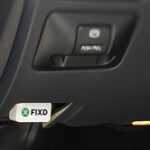The OBD2 port on a Volvo C30 is a crucial diagnostic tool. However, connecting an OBD2 scanner can sometimes trigger unexpected electrical problems. This article explores a scenario where a C30 experienced a series of malfunctions after an OBD2 scanner was plugged in, offering potential explanations and troubleshooting steps.
OBD2 Port Triggers Electrical Malfunction in Volvo C30
A Volvo C30 owner reported a strange incident involving the OBD2 port and subsequent electrical issues. While the car was running, connecting an OBD2 scanner caused the scanner to malfunction and the vehicle to experience multiple system failures. The dashboard lit up with warning messages, including anti-skid service required, brake system failure, and TPMS service required. The instrument cluster went dark, and the center console controls became unresponsive. However, the engine, A/C, and music system continued to function.
Turning off the engine didn’t immediately resolve the issue. The A/C and music continued to play, and the car wouldn’t restart. After a short period, the car seemingly reset itself, returning to normal operation. Subsequent attempts to connect the OBD2 scanner with the engine running replicated the problem. Connecting the scanner with the engine off, however, allowed it to function normally, revealing several error codes, including misfires on all cylinders, TCM circuit issues, loss of connection with the gear module, and high-speed CAN communication bus performance issues.
Possible Causes and Troubleshooting
The described scenario suggests a potential electrical problem within the Volvo C30. Several possibilities could explain this behavior:
Faulty OBD2 Port or Scanner
A damaged OBD2 port or a faulty scanner could cause communication errors and trigger the observed malfunctions. Inspect the OBD2 port for any signs of damage, such as bent pins or corrosion. Try using a different OBD2 scanner to rule out a scanner malfunction.
CAN Bus Communication Issues
The reported “high-speed CAN communication bus performance” error code points towards a potential problem with the car’s communication network. The CAN bus is responsible for transmitting data between various modules in the vehicle. A faulty wiring connection, a failing module, or even a software glitch could disrupt communication and lead to the observed symptoms.
Electrical Grounding Problem
A poor electrical ground connection can cause erratic behavior in electrical systems. Check the ground connections related to the OBD2 port, the engine control unit (ECU), and other relevant modules for tightness and cleanliness.
Software Glitch in ECU
A software glitch within the ECU could potentially cause unexpected behavior when the OBD2 port is accessed. Updating the ECU software to the latest version might resolve the issue. Consult a Volvo specialist for assistance with ECU updates.
Intermittent Starting Issue
The owner also reported an intermittent starting problem, where the car struggles to start after sitting overnight but starts fine on the second attempt. This issue suggests a potential fuel delivery problem.
Fuel Pump or Fuel Pressure Regulator
A failing fuel pump or a faulty fuel pressure regulator might not be able to provide adequate fuel pressure initially, leading to the starting problem. Checking fuel pressure with a gauge can help diagnose these components.
Fuel Injectors
Clogged or failing fuel injectors can also contribute to starting difficulties and misfires. Having the injectors professionally cleaned or replaced might be necessary. The reported misfire codes from the OBD2 scanner further support this possibility.
Conclusion
The unusual electrical issues triggered by connecting an OBD2 scanner to the Volvo C30 warrant further investigation. While several potential causes have been outlined, a thorough diagnosis by a qualified Volvo technician is recommended. Addressing the underlying electrical problem is crucial to prevent further malfunctions and ensure safe operation of the vehicle. Further diagnostics may involve checking wiring harnesses, testing individual modules, and using specialized diagnostic equipment.

